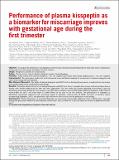Files in this item
Performance of plasma kisspeptin as a biomarker for miscarriage improves with gestation during the first trimester
Item metadata
| dc.contributor.author | Abbara, Ali | |
| dc.contributor.author | Al-Memar, Maya | |
| dc.contributor.author | Phylactou, Maria | |
| dc.contributor.author | Kyriacou, Christopher | |
| dc.contributor.author | Eng, Pei Chia | |
| dc.contributor.author | Nadir, Rans | |
| dc.contributor.author | Izzi-Engbeaya, Chioma | |
| dc.contributor.author | Clarke, Sophie A. | |
| dc.contributor.author | Mills, Edouard G. | |
| dc.contributor.author | Daniels, Elisabeth | |
| dc.contributor.author | Huo, Lechun | |
| dc.contributor.author | Pacuszka, Ewa | |
| dc.contributor.author | Yang, Lisa | |
| dc.contributor.author | Patel, Bijal | |
| dc.contributor.author | Tan, Tricia | |
| dc.contributor.author | Bech, Paul | |
| dc.contributor.author | Comninos, Alexander N. | |
| dc.contributor.author | Fourie, Hanine | |
| dc.contributor.author | Kelsey, Tom | |
| dc.contributor.author | Bourne, Tom | |
| dc.contributor.author | Dhillo, Waljit S. | |
| dc.date.accessioned | 2021-09-23T16:30:01Z | |
| dc.date.available | 2021-09-23T16:30:01Z | |
| dc.date.issued | 2021-09 | |
| dc.identifier | 273700366 | |
| dc.identifier | d2b3be88-0420-46cd-89fa-308b6d1c5e08 | |
| dc.identifier | 85107040532 | |
| dc.identifier | 000696488100041 | |
| dc.identifier.citation | Abbara , A , Al-Memar , M , Phylactou , M , Kyriacou , C , Eng , P C , Nadir , R , Izzi-Engbeaya , C , Clarke , S A , Mills , E G , Daniels , E , Huo , L , Pacuszka , E , Yang , L , Patel , B , Tan , T , Bech , P , Comninos , A N , Fourie , H , Kelsey , T , Bourne , T & Dhillo , W S 2021 , ' Performance of plasma kisspeptin as a biomarker for miscarriage improves with gestation during the first trimester ' , Fertility and Sterility , vol. 116 , no. 3 , pp. 809-819 . https://doi.org/10.1016/j.fertnstert.2021.04.031 | en |
| dc.identifier.issn | 0015-0282 | |
| dc.identifier.other | ORCID: /0000-0002-8091-1458/work/94669418 | |
| dc.identifier.uri | https://hdl.handle.net/10023/24015 | |
| dc.description | Supported by the National Institute for Health Research (NIHR) Clinical Research Facility and the NIHR Biomedical Research Centre based at Imperial College Healthcare National Health Services (NHS) Trust. The Section of Endocrinology and Investigative Medicine is funded by grants from the Medical Research Council and NIHR. A.A. is supported by an NIHR Clinician Scientist award (CS-2018-18-ST2-002). M.A.M. is supported by Tommy’s National Centre for Miscarriage Research . C.I.-E. is supported by an Imperial College-Biomedical Research Centre Imperial Post-doctoral, Post-CCT Research Fellowship. L.Y. is supported by an Medical Research Council Clinical Training Fellowship (MR/R000484/1). A.N.C. is supported by the NHS and Biomedical Research Centre. T.B. is supported by the NIHR Biomedical Research Centre based at Imperial College Healthcare NHS Trust. W.S.D. is supported by an NIHR Research Professorship (RP-2014-05-001). | en |
| dc.description.abstract | Objective: To compare the performance of kisspeptin and beta human chorionic gonadotropin (βhCG), both alone and in combination, as biomarkers for miscarriage throughout the first trimester. Design: Prospective, nested case-control study. Setting: Tertiary Centre, Queen Charlotte Hospital, London, United Kingdom. Patient(s): Adult women who had miscarriages (n = 95, 173 samples) and women with healthy pregnancies (n = 265, 557 samples).Intervention(s)The participants underwent serial ultrasound scans and blood sampling for measurement of plasma kisspeptin and βhCG levels during the first trimester. Main Outcome Measure(s): The ability of plasma kisspeptin and βhCG levels to distinguish pregnancies complicated by miscarriage from healthy pregnancies unaffected by miscarriage. Result(s): Gestation-adjusted levels of circulating kisspeptin and βhCG were lower in samples from women with miscarriages than in women with healthy pregnancies by 79% and 70%, respectively. The area under the receiver-operating characteristic curve for identifying miscarriage during the first trimester was 0.874 (95% confidence interval [CI] 0.844–0.904) for kisspeptin, 0.859 (95% CI 0.820–0.899) for βhCG, and 0.916 (95% CI 0.886–0.946) for the sum of the two markers. The performance of kisspeptin in identifying miscarriage improved with increasing length of gestation, whereas that of βhCG worsened. A decision matrix incorporating kisspeptin, βhCG, and gestational age had 83% to 87% accuracy for the prediction of miscarriage. Conclusion(s): Plasma kisspeptin is a promising biomarker for miscarriage and provides additional value to βhCG alone, especially during later gestational weeks of the first trimester. | |
| dc.format.extent | 11 | |
| dc.format.extent | 1186601 | |
| dc.language.iso | eng | |
| dc.relation.ispartof | Fertility and Sterility | en |
| dc.subject | Kisspeptin | en |
| dc.subject | Miscarriage | en |
| dc.subject | Pregnancy | en |
| dc.subject | QH301 Biology | en |
| dc.subject | RG Gynecology and obstetrics | en |
| dc.subject | T-NDAS | en |
| dc.subject | SDG 3 - Good Health and Well-being | en |
| dc.subject.lcc | QH301 | en |
| dc.subject.lcc | RG | en |
| dc.title | Performance of plasma kisspeptin as a biomarker for miscarriage improves with gestation during the first trimester | en |
| dc.type | Journal article | en |
| dc.contributor.institution | University of St Andrews. School of Computer Science | en |
| dc.contributor.institution | University of St Andrews. Centre for Interdisciplinary Research in Computational Algebra | en |
| dc.identifier.doi | 10.1016/j.fertnstert.2021.04.031 | |
| dc.description.status | Peer reviewed | en |
This item appears in the following Collection(s)
Items in the St Andrews Research Repository are protected by copyright, with all rights reserved, unless otherwise indicated.

